Peterborough's Bus War - Fen Travel
This article was originally written in 2002
Deregulation of bus service licensing in October 1986 led to 'bus wars' in many parts of the country, with large and small operators alike challenging other operators on profitable routes. Peterborough survived more or less untouched by this phenomenon, apart for a few months in 1992-93 when Fen Travel moved in.
Ralph Garratt had been the owner of Wreake Valley Travel of Leicester, but following a 'bus war' waged on the Leicester - Syston - East Goscote corridor, this company was bought out by Midland Fox. On 1 June 1992, Mr Garratt apparently bought Blands of Stamford (trading as Fairtax) from Midland Fox, although it is assumed that Midland Fox kept some kind of control. Fairtax continued running between Stamford and Peterborough via Wittering and Wansford on its service 27 (the erstwhile Barton 103 service).
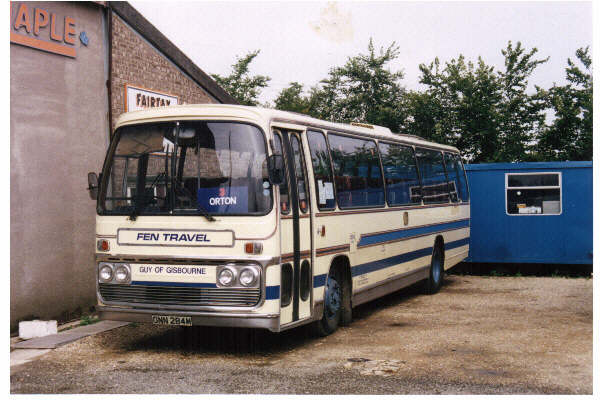
These three photos were taken at Ryhall depot on a Sunday in August 1992. Leopard/Plaxton ONN 284M was new to Barton. Most buses carried names.
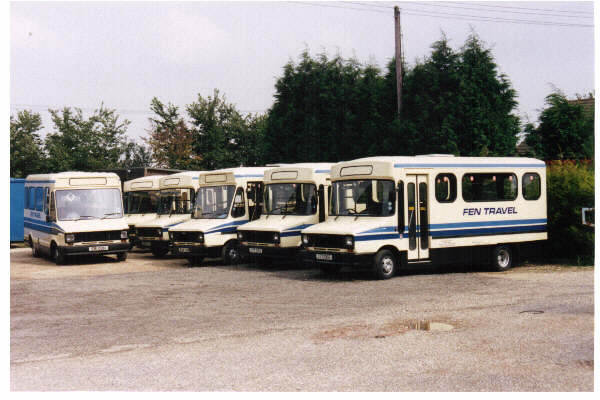
Fen Travel Sherpa midibuses - five of the six (left to right) are E81 OUH, D69 OKG, E104 OUH, D70 OKG and D73 OKG.
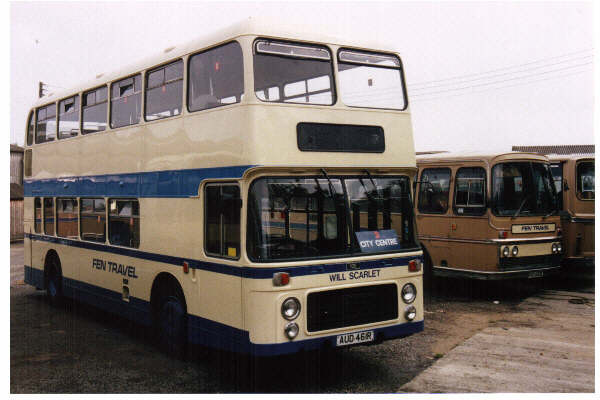
Bristol VRT AUD461R was new to City of Oxford and came via Midland Fox. Leopard RVO652L is in the background.
Shortly afterwards the company was renamed Fen Travel Ltd, and the assault on Peterborough's main corridors started on Monday 20 July 1992 with the introduction of service 3 from Queensgate to Orton Centre every 10 minutes via Oundle Road, Shrewsbury Avenue and the busway, mirroring Viscount's busy service 13 (now numbered 1).
All vehicles were based at the former Fairtax premises at Maples Yard, Essendine Road, Ryhall near Stamford (later an Arriva depot), and the service 27 timetable shows additional buses running from Stamford to Peterborough every 10 minutes from 0707 to 0747, obviously to take up service on route 3. They returned to Stamford every 10 minutes 1718 to 1808!
Vehicles consisted of an assortment of ex-Barton Leyland Leopards and various Sherpa and Ford Transit midibuses. There were also a couple of Bristol VRs, which were mostly for school services but found themselves in Peterborough during the school holidays. Vehicles were adorned with notices saying "We're here to stay" and "Fares held to 31/12/1992". Some of Viscount's extra buses came in the form of 'D' registered Metroriders hired from West Midlands Travel.
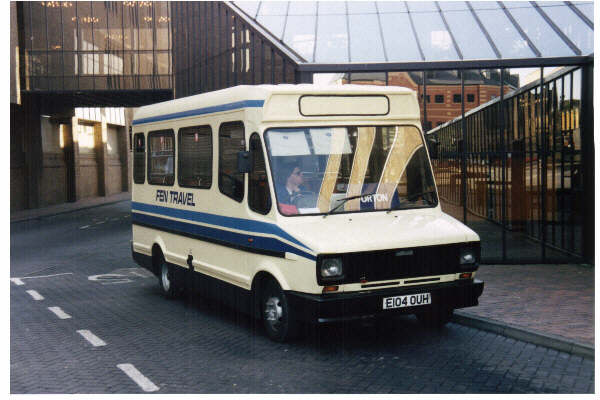
Fen Travel Sherpa E104 OUH at Queensgate on service 3 to Orton, August 1992
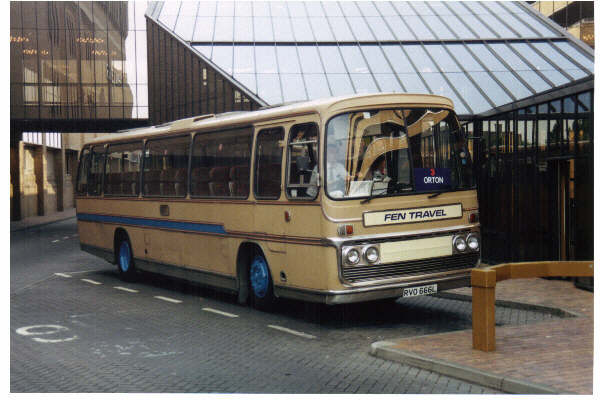
New to Barton, Leopard RVO 666L is also at Queensgate on service 3 to Orton, August 1992
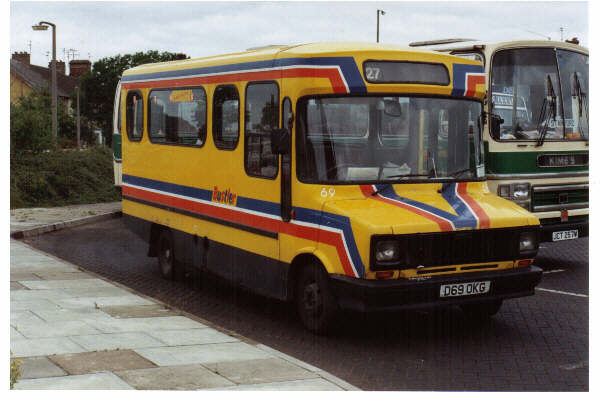
Freight Rover Sherpa D69 OKG carries a Carlyle body. New to National Welsh, it came to Fen Travel via Rhondda.
Viscount had been running four buses an hour to Orton; two on service 13 and a further two on service 14 via London Road. The Fen Travel service increased this to 10 per hour, and it soon rose to 14 per hour when Viscount increased its service (including a new route 12). Passengers also benefitted from lower fares: the old Viscount fare was £1.00 single, but Fen charged 60p single and £1.00 return, with a £4.00 weekly ticket. Viscount lowered relevant fares to match.
From Monday 10 August 1992 Fen Travel introduced its second route. Numbered 10, it followed the northern portion of Viscount's 13 (now 1), running from Queensgate to Werrington Centre. It ran every 15 minutes (0805-1720 from Queensgate, 0735-1750 from Werrington). Viscount's response was to increase the Werrington section of service 13 from half-hourly to every 10 minutes, which meant 10 buses per hour (previously two) between the two operators!
Newspapers soon began to carry headlines such as "It's War on the Buses" and the correspondence pages were full of letters, mostly supporting Fen Travel. Some, however, were critical that Fen were competing on existing routes rather than opening up new ones, and others realised that the price war could not be sustained in the long term. The Autumn 1992 edition of Viscount's public newsletter The Peterborough Traveller had contrasting pictures of its own immaculate yard, with buses neatly parked in rows, and that of Fen Travel.
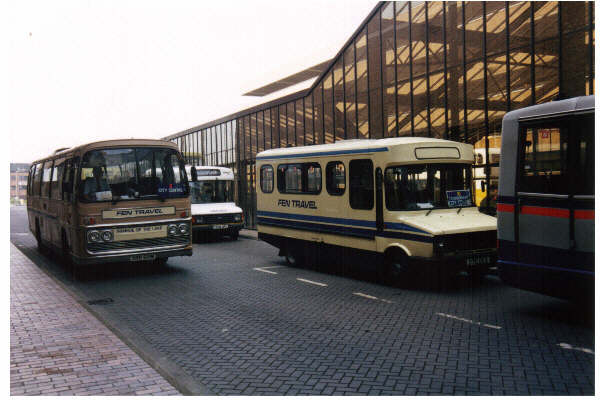
Three photos taken on 10 August 1992, first day of Fen Travel service 10 to Werrington Centre. Sherpa D70 OKG is on the 0920 journey, being passed by Leopard XRR 615M on service 3 from Orton.
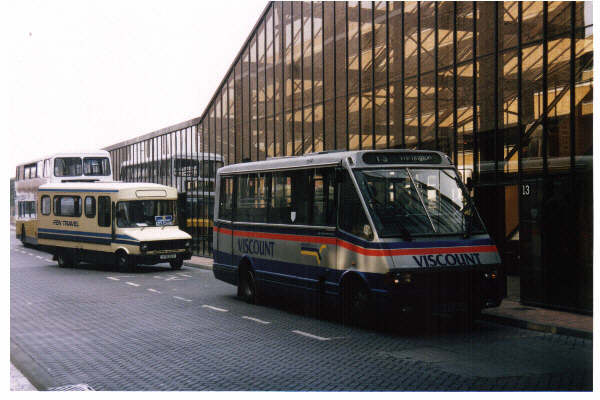
Another view of the 0920: Sherpa D70 OKG (ex Rhondda) is competing with a Viscount Metrorider on service 13, also to Werrington. The Metrorider is on hire from West Midlands Travel.
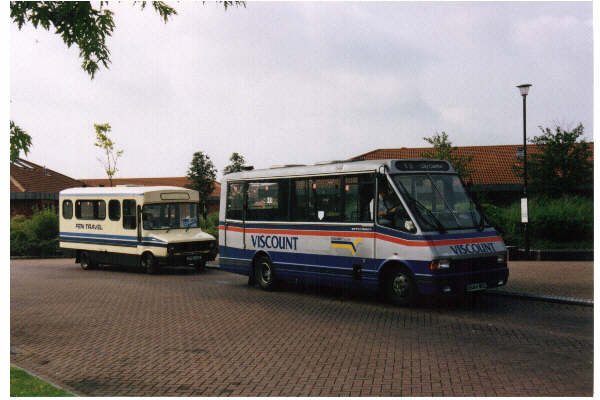
Having arrived at the other end of the route at Werrington Centre, Sherpa D70 OKG is again seen with Viscount Metrorider 644 (D644 NOE).
As with bus wars elsewhere in the country, certain 'tricks' were employed in the bid to compete for passengers. Viscount drivers used radio to swap information on waiting passengers, and Viscount sometimes ran 'half routes', legally it seems as they were extra services. Video cameras were allegedly used to monitor "irregular practices" on both sides. Viscount were also accused of blocking bays at the bus station on occasion, forcing Fen to unload in the carriageway.
From 26 October 1992 both the Orton and Werrington services were extended - service 3 to Orton Wistow and service 10 to Southwell Avenue via Hodgson Avenue and Twelvetrees Avenue. A new service 5 was introduced at the same time, mostly shadowing Viscount's 15 (later numbered 10) via Dogsthorpe Road and Gunthorpe to Werrington Centre. However, it also diverted via both branches of Viscount's route 7 to Paston Donaldson Drive and Paston Whitwell, and like route 10 also continued beyond Werrington Centre to Southwell Avenue. Frequency was every 15 minutes, reducing to every 30 minutes 1200 to 1430 (from Queensgate).
A few days later on 2 November, Viscount countered this by doubling the frequency of service 15 to four per hour, and introducing a new half-hourly service 6 to Paston.
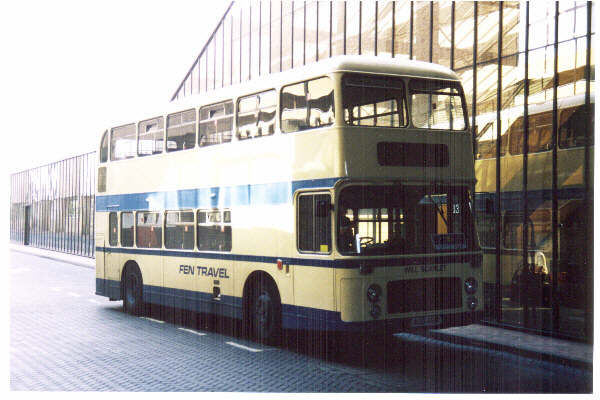
Fen Travel VR AUD461R Will Scarlet on service 10 to Werrington. The date is 12 August 1992
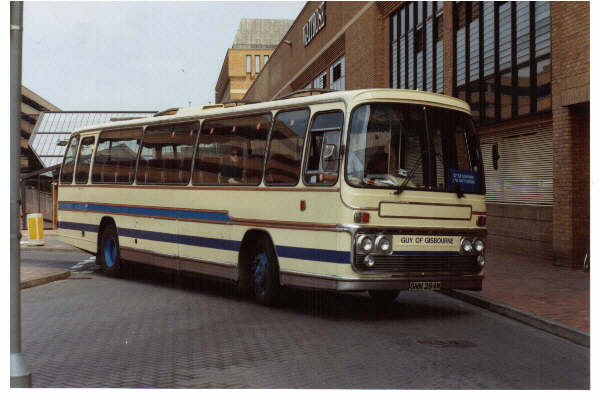
Another view of Leopard ONN 284M, new to Barton before passing to Midland Fox. The board in the window shows 27 Stamford via Wittering.
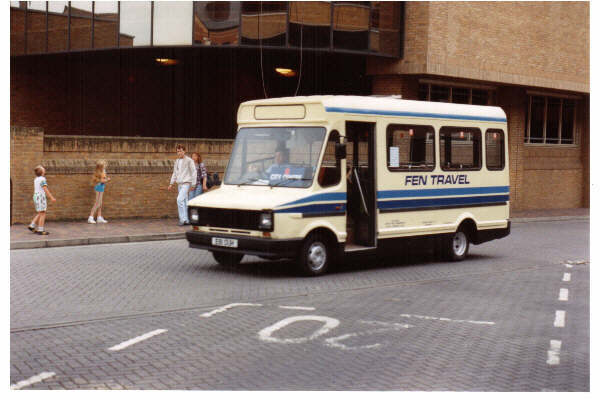
Seen on service 3 from Orton is Freight Rover Sherpa E81 OUH with Carlyle body, one of several new to National Welsh.
It is perhaps surprising that a route to Bretton was not introduced earlier. This came on 23 November 1992 with the start of Fen Travel's fourth route, numbered 15. For once the route introduced some useful new links rather than shadowing an existing Viscount service, and ran via the District Hospital and Westwood, then via North Bretton to Bretton Centre. Buses ran every 15 minutes (every 30 between 1200 and 1400 from Queensgate).
Although not shown in the timetable, and apparently not registered with the Traffic Commissioner (still necessary despite deregulation), Fen Travel's Bretton buses started running through to Edith Cavell Hospital. Viscount's Winter 1992 newsletter, delivered through peoples doors, carried an extensive item on the bus war and showed pictures of Fen Travel's buses "operating along an unregistered section of route" at the new hospital. It also claimed that Ralph Garratt was out to make a quick buck and that he "had said that if we paid him £250,000 he would go away for 3 years". As a result, Fen Travel apparently issued a writ against Viscount on December 23, suing them for libel, although I have no knowledge of the outcome.
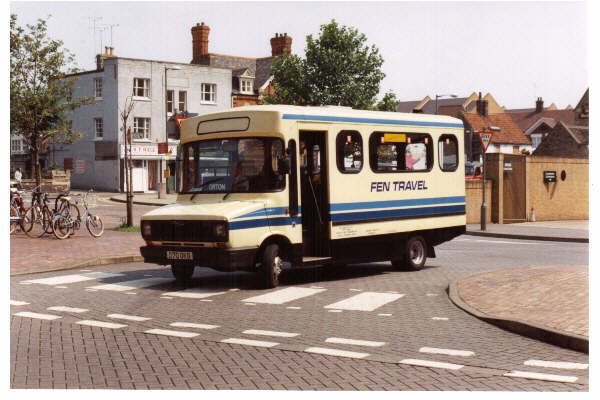
D70 OKG is a slightly older Sherpa with Carlyle body, again new to National Welsh.
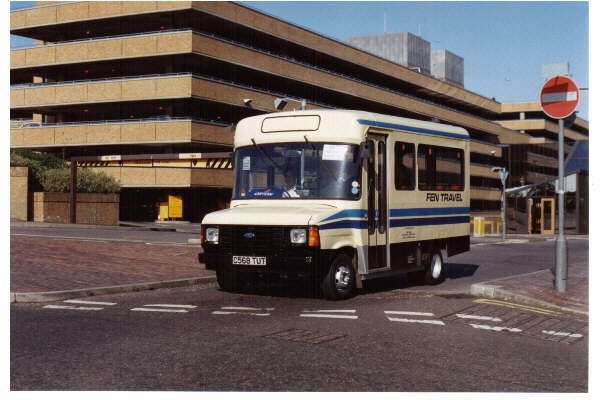
Dormobile bodied Ford Transit C568 TUT was one of many which formerly operated in Leicester with Midland Fox. It is leaving Queensgate for Orton on service 3.
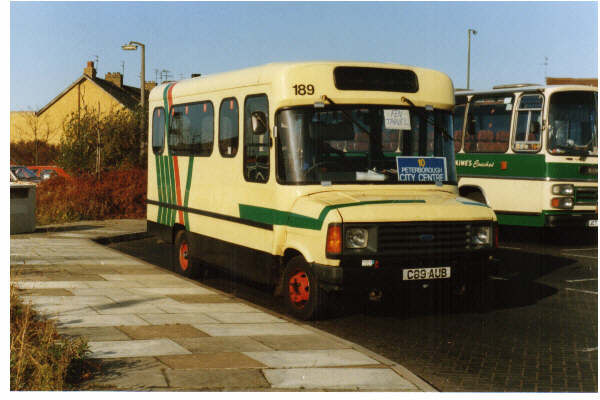
Another Ford Transit, but this time ex Yorkshire Rider and still in their livery is C89 AUB with a board for service 10. Bodywork is by Carlyle.
The extra buses did not please everybody, and one letter in the Peterborough Citizen claimed that the rivalry was "causing a nightmare" for residents in Paston, who were fearing for the safety of school children walking to school. The writer claimed to have counted 29 buses past his home in two hours.
With this number of buses running in Peterborough it was inevitable that something had to give. Quite how Viscount's finances fared during this period I don't know, but at 1830 hours on Saturday 27 February 1993 Ralph Garratt placed Fen Travel in voluntary liquidation, with the immediate loss of 29 jobs. Mr Garratt was reported as saying "The passenger support was good but wasn't enough to make it viable".
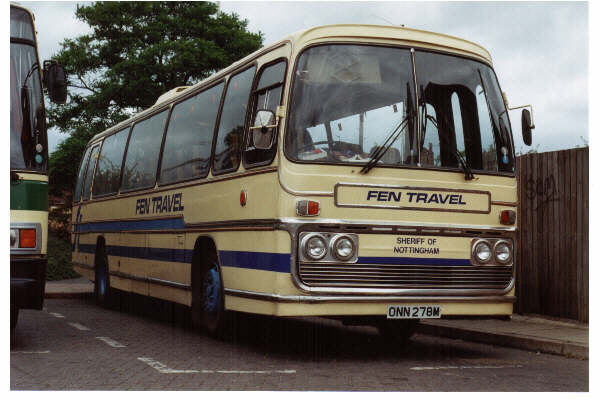
Another Leopard/Plaxton coach new to Barton and later with Midland Fox is ONN 278M. It carries the name Sheriff of Nottingham.
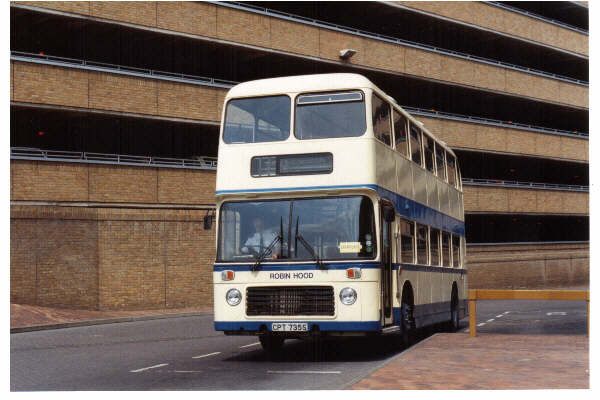
CPT 735S is a VRT with ECW body from United via Northumbria and Midland Fox. Seen here on the Stamford service, it occasionally found its way onto city services.
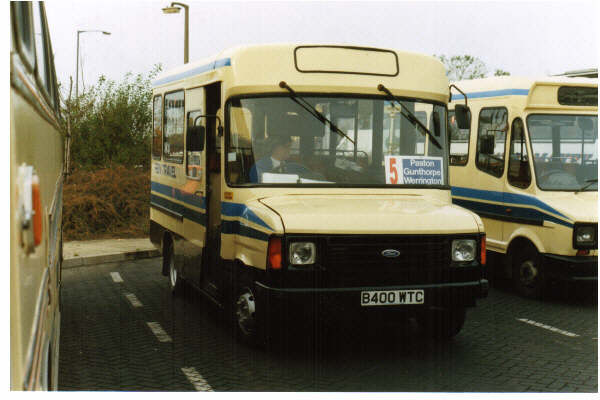
Robin Hood bodied Ford Transit B400 WTC came from Bristol via Midland Fox.
The 'bus war' only lasted a few months but the effect on Peterborough's bus services could still be felt years later. For example, even after the dust settled, Viscount continued to run eight buses per hour to Orton compared with four a year before (now every 10 minutes). On 30 November 1992 Viscount had introduced a new route 1 to Bretton via Westwood following Fen Travel's lead, and this service continued for some time, later numbered 2. Bretton (via North Bretton) settled down to a 10 minute frequency, which it retains today, compared with every 15 minutes before the competition came. Other areas have also benefitted from more frequent services.
Despite the existence of many operators in the area, they have since been content to tender for Council sponsored routes or stick to their traditional operating territory, rather than pit themselves against the giant Stagecoach group. Another 'bus war' would certainly be interesting, but the eventual outcome would almost certainly be the same as during those memorable months from July 1992 to February 1993.
Brendan Fox, 2002